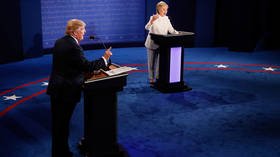Scientists use PHYSICS to explain why US elections are broken (but are they just centrists still bitter that Trump beat Clinton?)

A pair of Stanford scientists have used physics to explain why American presidential elections since 1970 reflect a society barely holding itself together. Innovative science or study into the biases of the researchers themselves?
The paper, which appeared last week in the journal Nature Physics, is by Yaneer Bar-Yam, president of the New England Complex Systems Institute, and Alexander Siegenfeld, a PhD student at MIT. At a glance, it is not obvious what insights into electoral politics physics may offer, although their paper is full of complicated equations and impressive-looking graphs.
But admittedly, the power of physics is that it can reach useful conclusions without necessarily needing all details of the underlying mechanisms. This is how physicists can make accurate predictions of the movement of planets and the mass of atoms, without understanding the fundamental nature of matter in the universe.
Also on rt.com We have legal age limits for driving, voting, and having sex, why not for transgender treatment?According to their paper, until 1970 US presidential elections had been working pretty well as a way of reflecting the political preferences of the majority. But something changed during the era of Richard ‘Tricky Dick’ Nixon. After him, very small changes in voter opinions have led to major swings towards more extreme candidates on both ends of the political spectrum. Bar-Yam says “What happened in 1970 is a phase transition like the boiling of water. Elections went from stable to unstable.”
Swinging pendulum
Whether it’s down to changes to the party primary system, scandals like Watergate or the Monica Lewinsky/Bill Clinton affair or to complex sociological trends, America has gotten more polarized in recent decades.
“Our country seems more divided than ever, with election outcomes resembling a pendulum swinging with ever increasing force,” Siegenfeld says. In this regime of “unstable” elections, he says, “a small change in electorate opinion can dramatically swing the election outcome, just as the direction of a small push to a boulder perched on top of a hill can dramatically change its final location.”
And the physicists show how shifting public opinion actually pushes election outcomes in the opposite direction. They imagine an election in which there are two candidates, one far-right and one center-left. If general public opinion has shifted to the left, then many far-left voters may dislike the centre-left candidate. They might opt not to vote in an election at all, and the far-left candidate may then sweep to victory.
In other words, as the electorate radicalizes, they would rather let the candidate from the opposite camp win than to support their own moderate. One could argue that Hillary Clinton was a victim of this – she did not appeal enough to the Democratic base, who saw her as being without principles and devoted to the status quo. Many stayed at home, and some even swung to Trump as a protest vote.
There is also an opposing scenario, in which a candidate favoured by a party’s base is rejected by the general public.
Take the American presidential primaries. A candidate must win over their party’s base in order to be nominated. But because the party members are concentrated at one end of the political spectrum, the winning candidate will likely be out of tune with the wider voting public.
Also on rt.com Soros pumps $1bn into ‘global education network’ to fight ‘climate change & dictators’ like Trump, Xi & ModiSo Bernie Sanders is promoted by the Democratic Party base, although the American electorate are horrified by the term ‘socialist.’
In the UK, backbencher Jeremy Corbyn was propelled to the Labour Party leadership by a massive membership of students and radicals, but was thrashed in the election.
Siegenfeld believes that this sort of “negative representation” undermines “the entire purpose of democratic elections.”
They recommend that countries adopt ranked-voting systems, so that people can still put their second-favorite “sensible candidates” along with their preferred ones. Though if we learn anything from how that works in real life – in countries where parties don’t operate a first-past-the-post system – that system can actually lead to fracturing and to the emergence of more leftfield candidates who can overcome the grandees.
They also like mandatory voting, which they say would reduce instability, though again it is doubtful if that would make a difference at the national level, the only place such a measure can realistically be applied.
An Ivy League outlook
But the real question is, what form of “stability” exactly would the physicists prefer to return to?
“Instability” is a loaded term, implying that there is some immutable center-ground towards which we should all be steering.
Also on rt.com Protests over citizenship law in India prove liberal elites only like democracy if they agree with the resultsThey fear the swinging pendulum, and a politics careening from left to right and back again every five years, as if each swing threatens to destroy the mechanism to which it is fixed.
Their ideal is presumably a succession of polished, professional status-quo politicians wearing different-colored ties but disagreeing only on cosmetic issues. A sort of 1990s “End of History” Third-Way consensus. Clinton and Blair, or Cameron, Merkel and Obama.
Whether that sort of politics is your version of heaven or hell should tell you how much value you want to attach to this particular study.
Like this story? Share it with a friend!
The statements, views and opinions expressed in this column are solely those of the author and do not necessarily represent those of RT.













